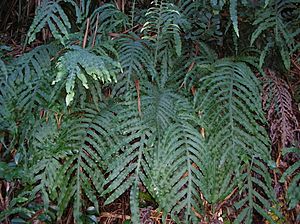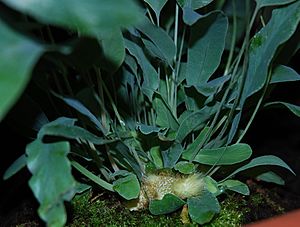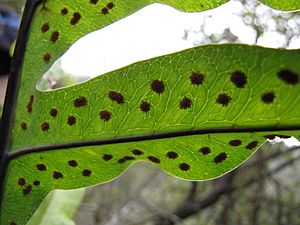Golden polypody facts for kids
Quick facts for kids Golden polypody |
|
|---|---|
 |
|
| Conservation status | |
| Scientific classification | |
| Synonyms | |
|
Polypodium aureum L. |
The Phlebodium aureum is a type of fern often called the golden polypody or blue-star fern. It's a plant that grows on other plants, like trees, but doesn't harm them. This fern is originally from warm, wet parts of the Americas, including tropical and subtropical areas.
Contents
What it Looks Like
This fern has a special underground stem called a rhizome. It creeps along and can be quite thick, usually about 8 to 15 millimeters wide. This rhizome is covered in shiny, golden-brown scales, which is how the fern got its name "golden polypody."
The leaves of this fern are called fronds. They are quite large, growing from about 30 to 130 centimeters long and 10 to 50 centimeters wide. Each frond is deeply cut into many smaller parts, called pinnae, and can have up to 35 of them. The fronds can be bright green or a bluish-green color, and their edges are often wavy.
If you look closely at the underside of the fronds, you'll see small, round spots. These are called sori (SOH-rye), and they contain tiny spores. These spores are like seeds for ferns and are carried away by the wind to grow new plants. The fronds stay green all year in places that get rain often. In areas with a dry season, they might lose their leaves for a short time.
Where it Lives
This fern is found mostly on the eastern side of the Americas. In the United States, it grows in Florida and a small part of southeast Georgia. It also grows south through the Caribbean islands, like the Bahamas and Puerto Rico. You can find it in northern and eastern South America, all the way down to Paraguay.
The Phlebodium aureum is the only type of Phlebodium fern found in North America. All the other kinds of Phlebodium ferns live only in South America.
Where it Grows
This fern usually doesn't grow directly in the ground. Instead, it often lives high up in the tops of trees in tropical rainforests. It also grows on small palm trees in subtropical forests. It's very common in the cloud forests of the Caribbean and northern South America, which are forests often covered in clouds.
In Florida, you can find it in different places, like wet swamps and dry, shady areas called hammocks. This shows that it can live in many different small environments. This fern needs warm weather and can't handle cold temperatures or even light frosts for very long. It also needs a lot of light to grow well. Because it can lose its leaves during dry times, it can survive in places that get a bit dry.
How People Use It
The Phlebodium aureum fern is easy to grow and is popular as an ornamental plant because it looks nice. It's also used in herbal medicine.
You can grow this fern in special greenhouses in places that aren't tropical, as long as the night temperature stays above about 5 degrees Celsius (41 degrees Fahrenheit). There are different types of this fern that people have grown for gardens. They have leaves that can be grey-green, silver-green, or blue-green, and some have very wavy frond edges.
Medicine
In Central America, people have traditionally used liquids made from this fern as a general medicine for many problems. These fern "tonics" were given for a wide range of sicknesses, from asthma to heart disease.
Modern scientists have also looked into P. aureum for medicine, often using its older name, Polypodium leucotomos. Studies have explored using extracts from this fern to help with skin problems like melasma (dark spots), vitiligo (loss of skin color), psoriasis (scaly patches), and skin damage from the sun.
Research has shown that taking Polypodium leucotomos extract can help protect the skin from damage caused by ultraviolet (UV) light from the sun. Studies have found that it protects against both UVB and UVA light. A review of many studies found that this fern extract was safe to use and didn't cause many side effects. Because of this, some suggest using Polypodium leucotomos along with regular sunscreens to get extra sun protection.
How Scientists Classify It
Phlebodium aureum belongs to a small group of ferns that scientists have only recently separated into their own genus. Before, it was part of the Polypodium genus, which is why you might still see its old name used sometimes.
The Phlebodium genus is one of 178 genera in the fern family called Polypodiaceae. Within this family, Phlebodium is part of a group called the Polypodioideae subfamily. Its closest relative is likely the Polypodium genus, from which it was separated. Other related ferns include Pecluma, Pleopeltis, and Microgramma.
Scientists decided to create a new genus for Phlebodium because it has some clear differences. For example, its spore clusters (sori) are smoother and rounder than those in other groups within the Polypodiaceae family. Also, studies on its spores and the size of the mature plant show that Phlebodium is quite different from the rest of its family.
The Polypodiaceae family is closely related to the Davalliaceae family. These ferns are part of a larger group called the Polypodiales order, which includes about 80% of all fern species we see today. This order of ferns developed and became very diverse about 100 million years ago, and they are considered some of the most advanced ferns in terms of evolution.
See also
 In Spanish: Phlebodium aureum para niños
In Spanish: Phlebodium aureum para niños




